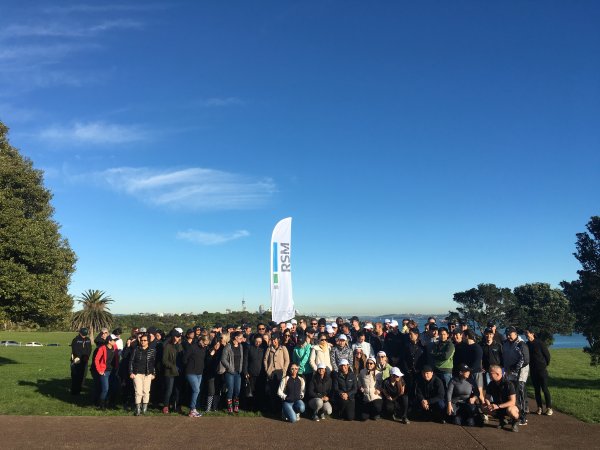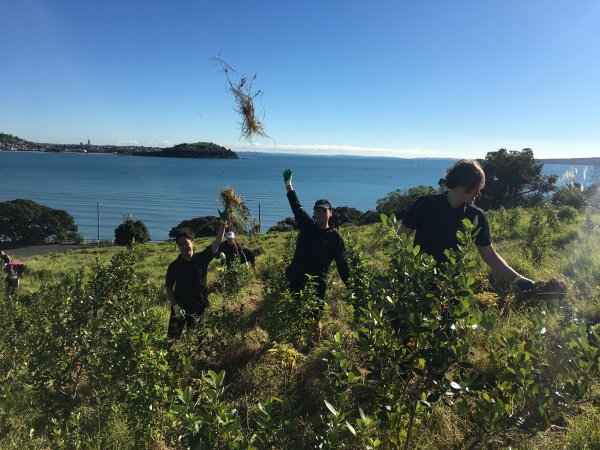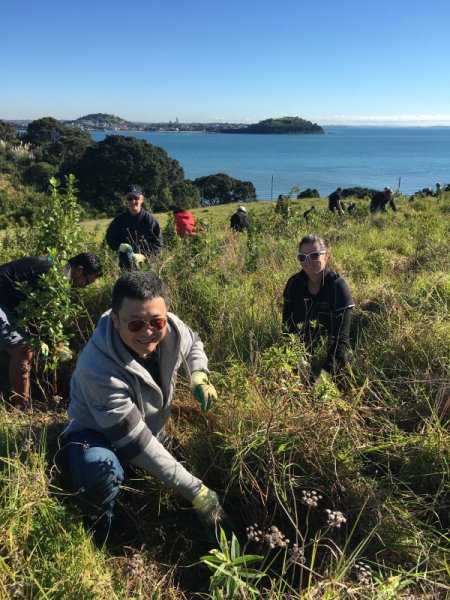A day when the independent member firms of the RSM network celebrate our shared values of Understanding, Collaboration and Ideas and Insight – this year, with an innovative twist.
September marks ‘Innovation month’ internationally across all RSM member firms, in line with this, RSM New Zealand took the opportunity to mark our global day by thinking innovatively about land use for the future, in the form of planting, preparation and conservation of native bush.
We at RSM believe that innovation is not only driven by technological advances, but also through novel ways of investing in the future of New Zealand success, namely in the trifector of diversity, environment and tourism.
The three New Zealand offices came together on Bastion Point (Takaparawhau), a beautiful headland reaching into the Auckland harbour, to weed, plant, and assist Ngāti Whātua Ōrākei in their efforts to restore the natural bush to benefit the tangata whenua (people of the land) and “bring the birds home”.

The benefits
Spending time physically working together as a team in a totally different work environment, and with colleagues we don’t normally work alongside was a great way to deepen relationships and trust and gain a deeper understanding of the skills and diversity in our team. We were able to apply our team’s time and efforts to do some long-term good and celebrate the lovely city we live in and its cultural diversity.
Our efforts will help many generations to enjoy native bush and birds in our city, our team directly helped to protect the things that belong in this space - native plants, birds and insects and their support systems and food supplies - planting helps maintain and enhance biodiversity. Spending time focusing on environmental success and sustainability provides a powerful parallel for innovation and success in business.
The best time to plant a tree is 20 years ago. The second best time is now.

The day
It was a very special day for RSM - we were led onto the Takutaimoana work depot with a rousing rendition of Pokarekare Ana. Similar to the reality of much of work life; it was not glamorous, but it was foundational and important. We cleared weeds around plants that had been planted five years previously, to ensure they had enough sun and space to grow - preserving the land for the generations to come.
While the weather was cool the sun shone brightly and we had the fantastic backdrop of the beautiful glistening Waitamatea harbour. We gifted Ngāti Whātua Ōrākei a koha of four large Kauri trees to add to the grove of trees gifted the year previous, which we will be able to see grow and prosper in the years to come.
As business advisors we know that every successful venture requires planning and preparation. It also must be sustainable. We sincerely hope that everyone enjoyed RSM World Day 2017 - connections were strengthened as we celebrated what it means to be RSM. Thank you to the RSM team, and thank you to Ngāti Whātua Ōrākei for all your ongoing good work and making this endeavour possible.
He aha te mea nui o te ao? He tangata, he tangata, he tangata. What is the most important thing in the world? It is the people, it is the people, it is the people.

The land and history
Takaparawhau is a coastal piece of land with a rich history synonymous with land rights. Pre-colonisation, Takaparawhau was occupied by Ngāti Whātua, however the surrounding land was confiscated by the NZ Government for public works and development over a period from the 1840s into the 1950s. In 1885 the New Zealand Government built a military outpost at Kohimarama and in 1886 the Crown used the Public Works Act 1882 to take ownership of 13 acres of Takaparawhau for the purpose of defence. In 1941, when the Crown no longer needed Takaparawhau for defence, the land was not returned to Ngāti Whātua but instead gifted to the Auckland City Council for a reserve.
In 1977 the announcement of a housing development on the land resulting in the Ōrākei Māori Action Committee taking direct action to stop the development and prevent the land confiscation. The protesters occupied the land for a period of 506 days finally ending on 25 May 1978 when police and army arrived en masse to forcibly remove them – destroying the temporary buildings - including vegetable gardens and a meeting house, and arresting 222 protesters. The occupation and the use of force to end it played a part in highlighting land injustice against Māori, and the occupation became a major moment in the history of land ownership protests. In the 1980s New Zealand Government returned the land to Ngāti Whātua, with compensation, as part of a Treaty of Waitangi settlement process.
Orakei Reserves Trust chair Sharon Hawke says the hapu is gradually reforesting much of the 27 hectares of whenua rangatira that came back in the 1991 treaty settlement.
"We’re depositing back into Papatuanuku her taonga, her tamariki, actively physically connecting with her as part of building and fortifying our own wairua” says Sharon Hawke
In order to stay relevant to our existing clients, prospects, markets and our profession, we need to regularly reassess what makes RSM an innovative network and how we can continue to be forward thinking.
